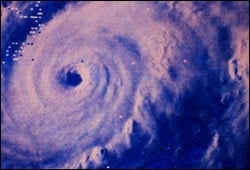 |
|||||||||||||||||||||||||||||||||
|
Hurricanes The Basics
What is it? A hurricane is a swirling storm measuring 60-1,000 miles in diameter that forms over warm ocean waters. Hurricanes start life as a cluster of strong thunderstorms moving across the ocean, called a tropical disturbance or tropical wave. Atmospheric conditions must be just right to turn a tropical wave into a hurricane — less than 5% of them ever become full-blown hurricanes. A tropical wave that begins spinning around a center of low pressure is called a tropical depression. Tropical depressions have maximum sustained wind speeds of less than 40 mph at the ocean's surface. When the maximum winds reach 40 mph or greater, the storm changes into a tropical storm, and it's given a name. Once the maximum winds reach 74 mph or greater, the storm becomes a hurricane. Each hurricane has an eye of calm winds and low pressure, surrounded by an eyewall of intense thunderstorms with high winds and heavy rain. Spiral bands of intense thunderstorms spiral into the eyewall of the hurricane from the outer parts of the storm. The generic name for a hurricane is tropical cyclone. These storms are called typhoons when they occur in the western Pacific Ocean, and cyclones in the Indian and southern Pacific Oceans. Most hurricanes happen between June 1 and November 30. Warmer water temperatures are one reason there are more hurricanes in the summer. |
||||||||||||||||||||||||||||||||

